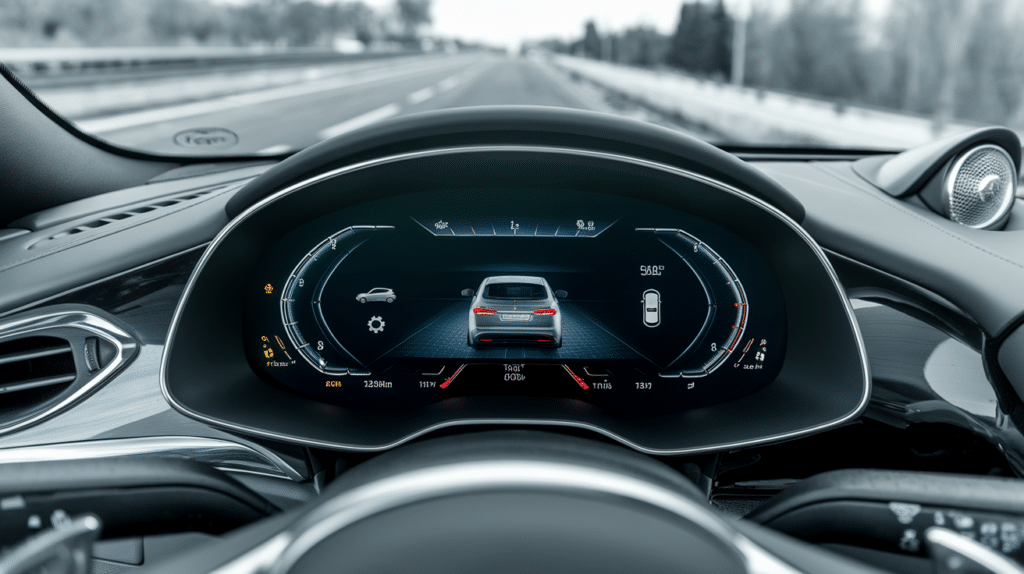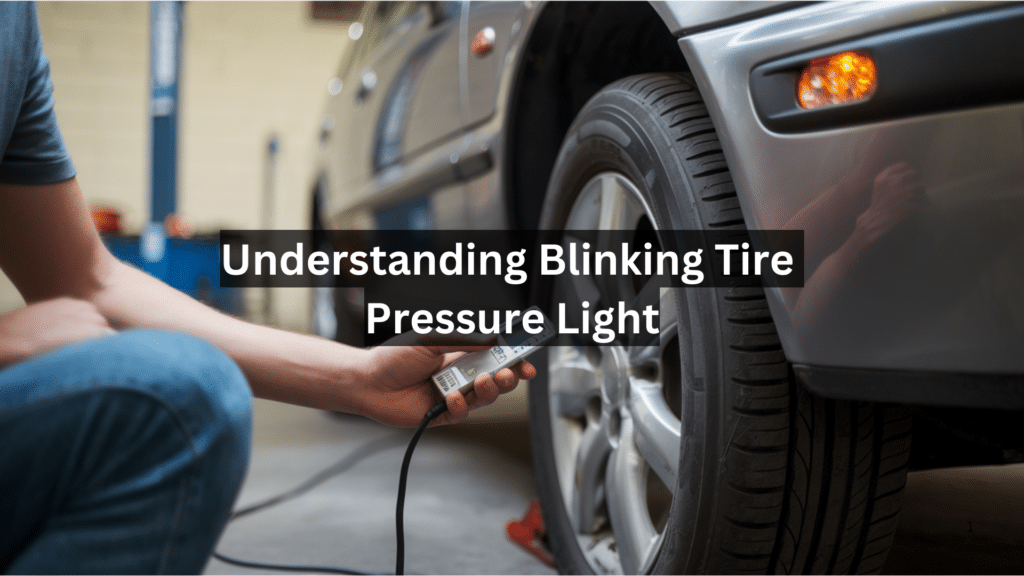That blinking tire pressure light on your dashboard can be confusing and stressful. Is it dangerous? Can you still drive? Do you need a tow truck?
I understand your worry. In this article, I’ll explain:
- What that blinking light means
- The 5 most common causes
- Simple steps to check your tires yourself
- When you should get professional help
As a car owner for over 15 years, I’ve encountered this problem multiple times. The good news is that it’s rarely as serious as it seems.
Whether you’re parked with a blinking light or want to be prepared for the future, you’ll find your answer here. No mechanic jargon—just clear, actionable advice that will solve your problem and get you back on the road safely.
What Does a Blinking Tire Pressure Light Mean?

A solid tire pressure light usually means one or more of your tires is low on air.
But a blinking tire pressure light? That’s different.
When your tire pressure light blinks for about 60-90 seconds before staying on, it usually signals a problem with the Tire Pressure Monitoring System (TPMS) itself.
Think of it like this: a steady light means “check your tires,” while a blinking light means “check the system that checks your tires.”
Possible Causes of a Blinking Tire Pressure Light
A blinking tire pressure light can be frustrating, but it usually points to a specific issue with your tires or sensors. Understanding the possible causes can help you take the right steps to resolve the problem.
Let’s look at each possible cause in detail:
TPMS Sensor Malfunction
- The sensors in your tires can break or fail. These small devices measure air pressure inside your tires.
- They take a beating from road conditions, heat, and constant movement. After 5-7 years, they often start to fail.
- A broken sensor can’t send the correct information to your car’s computer, causing the light to blink.
Dying Sensor Batteries
- Each TPMS sensor has its own tiny battery. These batteries can’t be replaced separately – the whole sensor must be replaced when the battery dies.
- Most sensor batteries last 5-7 years. When they lose power, they send weak or inconsistent signals that lighten your dashboard.
Extreme Temperature Changes
- A sudden drop in temperature can cause your tire pressure light to act up. Air contracts when cold, reducing tire pressure.
- If you park your car overnight and the temperature drops 20 degrees, you might see a blinking light in the morning.
- This usually stops after driving for 15-20 minutes as your tires warm up.
Recent Tire Service
- If you recently had your tires rotated, replaced, or serviced, the TPMS might need to be reset.
- During service, sensors can be disturbed from their original positions or programming.
- Some vehicles automatically relearn sensor positions, but others need a manual reset procedure after tire service.
Electronic Interference
- TPMS sensors use radio frequencies to communicate with your car’s computer.
- Other devices that use similar frequencies can sometimes cause interference. This includes power lines, radio towers, and cell phone chargers.
- I once had my light start blinking while parked near a radio station. The interference usually goes away when you drive to a different location.
How to Check Your Tire Pressure
Even if the blinking light suggests a system problem, you should still check your tire pressure.
Here’s how:
- Wait until your tires are cold (at least 3 hours after driving)
- Find the recommended pressure in your driver’s door jamb or owner’s manual
- Remove the valve cap from each tire
- Press the pressure gauge firmly onto the valve stem
- Read the number and compare it to the recommended pressure
- Fill any low tires to the proper level
Don’t go by the maximum pressure listed on the tire sidewall. That’s not the recommended pressure for your specific vehicle.
What to Do if You Can’t Find the Problem
Can’t figure out why that light is blinking? Don’t panic.
If you check all four tires (plus the spare in some vehicles) and they have the correct pressure, you probably have a system issue.
Your options include:
- Check your owner’s manual for reset procedures
- Try the TPMS reset button if your vehicle has one (often under the steering wheel)
- Drive at over 50 mph for about 10 minutes to see if the system recalibrates
- Visit a professional if the light continues blinking
Remember: Blinking usually indicates an issue with the monitoring system, not necessarily a dangerous tire condition.
What Should You Do When the Light Is Blinking?
When your tire pressure light starts blinking, it’s a sign that something’s wrong with your tires or the sensor itself. Ignoring the light can lead to unsafe driving conditions, so it’s important to take quick action.
Here’s what you should do to address the issue and keep your vehicle running smoothly:
- Don’t panic. A blinking light rarely means imminent danger.
- Check your tire pressure at your next convenient stop.
- Look for visible problems like nails, bulges, or obvious low pressure.
- Drive cautiously until you can fully address the issue.
- Get the TPMS checked if the light continues to blink after you’ve verified proper tire pressure.
I once ignored a blinking tire pressure light for two weeks. Not smart! It turned out that one of my TPMS sensors had failed and needed replacement.
Preventing Future Issues
It’s important to stay proactive with tire maintenance to prevent tire pressure light issues in the future. By performing simple tasks like rotating tires and inspecting for leaks, you can keep your vehicle running smoothly and safely.
Want to avoid that blinking light in the future?
Try these tips:
- Check tire pressure monthly, not just when the light comes on
- Keep a quality tire gauge in your glove compartment
- Have your TPMS sensors checked during regular maintenance
- Remember that TPMS sensor batteries typically last 5-7 years
- Be aware that extreme weather changes can affect tire pressure
Your TPMS is just a backup system. Being proactive about tire maintenance is still your responsibility.
Common Myths About Tire Pressure Light
Many drivers believe a blinking tire pressure light is nothing to worry about, but this misconception can lead to bigger problems. In this section, we’ll address some common myths and clear up any confusion about what the tire pressure light means.
Let’s bust some myths:
Myth: The TPMS Will Alert You Before a Tire Gets Dangerously Low
Truth: Most systems only alert when pressure is 25% below recommended levels.
Myth: You Must Go to A Dealer to Reset the TPMS
Truth: Many vehicles have reset procedures you can do yourself.
Myth: The Spare Tire Is Monitored by The TPMS
Truth: In most vehicles, the spare is not monitored.
Myth: Filling Tires with Nitrogen Prevents TPMS Warnings
Truth: While nitrogen maintains pressure better over time, it doesn’t affect how the TPMS functions.
Conclusion
That blinking tire pressure light is usually a system issue, not a dangerous tire problem. But it’s still a warning you shouldn’t ignore.
Always check your tire pressure first. It’s the quickest and easiest solution. If your tires have proper air, then the system itself needs attention.
Remember that driving on underinflated tires is dangerous. It can lead to poor handling, reduced fuel economy, and even blowouts at high speeds.
Don’t let that blinking light ruin your day. Now you know what it means and exactly what to do. You can handle this simple car problem yourself in most cases.
Take care of your tires, and they’ll take care of you on the road!
Frequently Asked Questions
Can I Drive with a Blinking Tire Pressure Light?
Yes, you can usually drive with a blinking tire pressure light. Check your tire pressure at the next convenient stop to ensure they’re properly inflated.
How Much Does It Cost to Fix a TPMS Sensor?
Replacing a TPMS sensor typically costs between $50 and $100 per tire. This includes the part and labor, but prices may vary depending on your vehicle’s make and model.
Will the TPMS Reset Itself After Filling the Tires?
Sometimes, the TPMS will reset itself after driving for about 10 minutes at speeds over 50 mph. If it doesn’t, you may need to use the reset button or visit a mechanic.
Can the Weather Affect My Tire Pressure Light?
Yes, cold weather can cause tire pressure to drop, triggering the light. For every 10°F drop in temperature, tires can lose about 1 PSI of pressure.
Do All Cars Have Tire Pressure Monitoring Systems?
By law, all cars sold in the U.S. since 2008 have TPMS. Older vehicles may not have this system, so you must manually check tire pressure.


